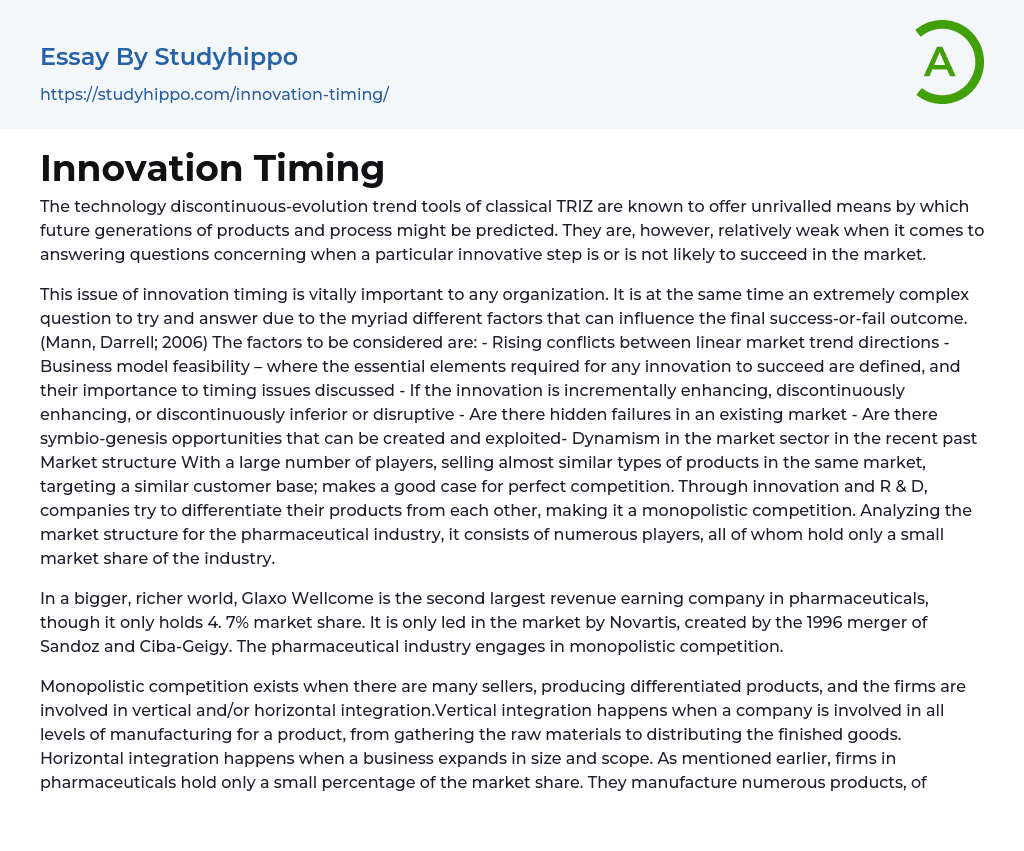Classical TRIZ tools in technology discontinuous-evolution trend are known for their exceptional ability to predict the future generations of products and processes. However, they lack effectiveness in determining the success or failure of an innovative step in the market. This issue of timing is crucial for any organization, but it is complex due to various factors influencing the outcome. These factors include conflicts in market trend directions, feasibility of business models, the nature of innovation (enhancing, inferior, or disruptive), existing market failures, opportunities for symbio-genesis, and market dynamism.
In terms of market structure, when a large number of competitors sell similar products to a similar customer base in the same market, it fosters perfect competition. To differentiate themselves, companies resort to innovation and research and development, resulting in monopolistic competition.The pharmaceutical industry's market structure involves multiple players, each holding a small
...market share.
Glaxo Wellcome, with a 4.7% market share, is the second largest revenue earning company in the pharmaceuticals industry. The leading company in the market is Novartis, which resulted from the merger of Sandoz and Ciba-Geigy in 1996. It is worth noting that the pharmaceutical industry operates under monopolistic competition.
Monopolistic competition involves multiple sellers producing different products and engaging in vertical and/or horizontal integration. Vertical integration refers to a company's involvement in all stages of product manufacturing, including sourcing raw materials and distributing final goods. Horizontal integration entails business expansion in size and scope. In the pharmaceutical industry, companies have a small market share but offer a wide range of products, often specializing in specific product lines. For example, Bristol-Myers Squibb specializes in developing treatments for various medical conditions such as cancer, cardiovascular diseases, metabolic
disorders, infections, skin issues, nervous system disorders, diabetes, and immune system disorders. From an Industrial Organization perspective, there is a question about whether an economic environment with large companies and some level of market concentration outperforms perfect competition in terms of dynamic efficiency. Arrow can be considered as the two main researchers studying this matter.
The majority of the literature on innovation, especially in the Industrial Organization framework, centers around the two Schumpeterian Hypotheses (Schumpeter, 1942). The first hypothesis focuses on the connection between innovation and monopoly power, stating that a concentrated market structure promotes innovation. The second hypothesis examines the relationship between firm size and the willingness to invest in innovation activities. According to Shumpeter (1942), monopolists have a higher likelihood of attracting qualified scientists and technicians and face fewer financial constraints. Research and development (R&D) investments are inherently riskier than investments in physical capital. However, potential revenues from successful innovations are usually very high (Sherer et al. 2000). Therefore, firms capable of bearing risk and financing their investments are more likely to engage in innovation. These firms can leverage their existing market power to acquire resources for R&D. The result of this process allows firms to maintain their market power, generate higher profits that further boost R&D investment, and increase the likelihood of continuous innovation.
(Crespi; 2004,p. 7) Arrow (1962a) discovered that perfect competition provided the greatest motivation for innovation. According to his findings, a monopolistic firm is less likely to invest in research and development compared to a competitive firm. The reason behind this is that a monopolist already earns guaranteed profits from its monopoly position even before any innovation takes place. On the
other hand, under perfect competition, all profits are generated by the introduction of an innovation, thus creating greater incentives to invest in research and development.
According to Crespi (2004, p. 8), a monopolist earns less profit from an innovation compared to a new entrant. This is because the monopolist only replaces a portion of their existing profits, while for the new entrant, the profits from the innovation are entirely new.
- Automobile essays
- Bus essays
- Civil engineering essays
- Cycling essays
- Electric Car essays
- Genetic Engineering essays
- Hybrid essays
- Innovation essays
- Internal Combustion Engine essays
- Invention essays
- Mechanical Engineering essays
- Mechanics essays
- Software Engineering essays
- Telephone essays
- American Dream essays
- Barriers To Entry essays
- Capitalism essays
- Central Bank essays
- Compensation essays
- Consumerism essays
- Economic Development essays
- Economic Growth essays
- Economic Inequality essays
- Economic System essays
- Economy essays
- Employment essays
- Export essays
- Finance essays
- Free Trade essays
- Gross Domestic Product essays
- Human Development essays
- Income Inequality essays
- Industry essays
- Inflation essays
- International Business essays
- International Trade essays
- Macroeconomics essays
- Materialism essays
- Max Weber essays
- Microeconomics essays
- Minimum Wage essays
- Monetary Policy essays
- Monopoly essays
- Pricing essays
- Profit essays
- Recession essays
- resources essays
- Taxation essays
- Trade essays
- Unemployment essays




